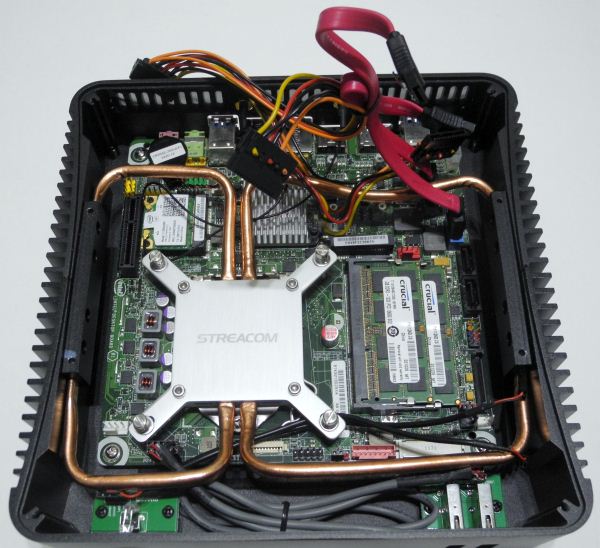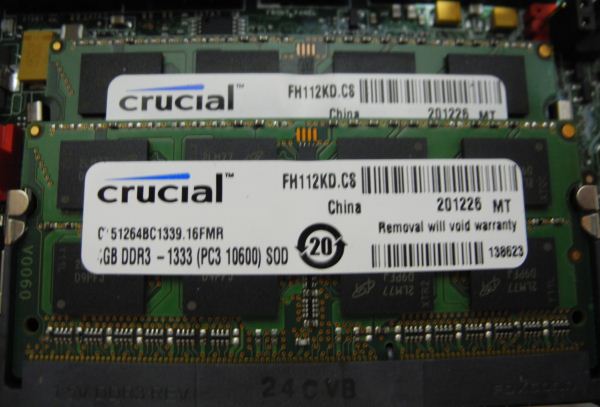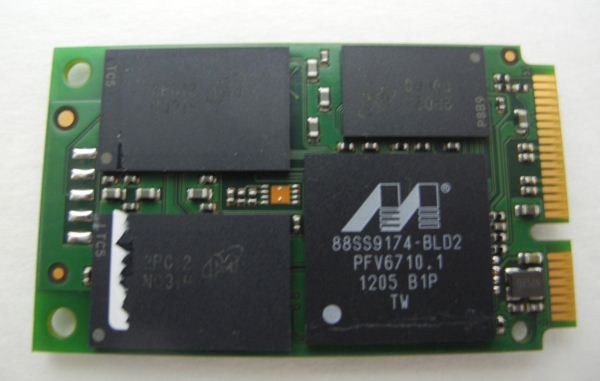Aleutia Relia Industrial PC Review: Ivy Bridge & Q77 in a Fanless Chassis
by Ganesh T S on December 4, 2012 10:00 AM EST- Posted in
- Industrial PC
- HTPC
- Ivy Bridge
- Aleutia
System Teardown and Analysis:
The Aleutia Relia's most interesting aspect is the passive cooling. In order to understand the thermal solution and also take a look at the internal components, we disassembled the system. It was quite easy to take apart, with the top being held in place by four screws. Of particular interest is the thin gauzelike fabric pasted around the ventilation slots on the top panel (and also present beneath all the other ventilation slots). This makes the unit dust-resistant. Since there are no moving parts to move the dust inwards, this porous gauzelike material is capable of shutting out most of the dust. Of course, it doesn't make it dust proof, but offers an added layer of protection. Beneath the top panel, we have a bar with two hard disks fastened on to it. The bar itself is fastened to the side panels using four screws. Beneath this disk assembly, we have the main board and the passive cooling solution. The gallery below presents some of the teardown pictures
Motherboard & Chipset : mITX DQ77KB with Q77 Express
The Aleutia Relia is based on the Intel DQ77KB motherboard which contains the Q77 Express chipset. This mini-ITX board supports direct 19 V DC input (no need for a PSU -- except for the AC - DC adapter). It has two SO-DIMM sockets, four USB 3.0 ports, eight USB 2.0 ports and five SATA ports (2 x SATA 6 Gbps, 2 x SATA 3 Gbps, 1 x mSATA). The mSATA port is a full mini-PCIe card slot. In addition, the board also has a half-mini card slot taken up by the WLAN solution and an empty PCIe 3.0 x4 add-in card slot (unusable in the Relia).
The board also has the Realtek ALC892 audio codec along with two GbE ports.
CPU & GPU : Intel Core i7-3770T / Intel HD Graphics 4000
The Core i7-3770T is a 4C/8T processor belonging to the Ivy Bridge family. It has a TDP of 45 W. Clocking in at 2.5 GHz, it is capable of going up to 3.7 GHz in Turbo Mode. 8 MB of L3 cache is shared between the integrated GPU (HD4000) and the CPU cores. The GPU runs at 650 MHz, but, can turbo up to 1.15 GHz under certain conditions. It supports full 3D video capabilities, QuickSync v2.0 and WiDi. However, WiDi isn't supported by the DQ77KB as it is an unnecessary feature in the target market.
DRAM: Crucial 2 x 4GB DDR3-1333
The Aleutia Relia uses two Crucial CT51264BC1339 4 GB SODIMM kits. It has a CAS latency of 9-9-9-24.
Considering that the Relia has a 3rd generation Core processor in the i7-3770T, we expected Aleutia to go in for DRAM rated at 1600 MHz.
Storage Drives : Crucial CT128M4SSD3 128 GB mSATA SSD / 2 x 500 GB Western Digital Scorpio Black WD5000BPKT
The unit uses a 128 GB Crucial mSATA SSD as the primary drive and two 2.5" 500 GB Western Digital hard disks as secondary drives. The review unit had the two hard drives configured as separate drives. However, it is possible to set up the BIOS to put them in RAID-0 or RAID-1 depending on the requirements.
The Scorpio Black drives operate at 7200 rpm and has a 16 MB cache. The Black series has a warranty period of 5 years. It is generally regarded as one of the highest performing 2.5" hard drives in the market. The primary drive (Crucial mSATA SSD) is much more interesting. Unlike the Phison based mSATA SSD we saw in the Zotac ZBOX Nano XS, this one has bona fide credentials and has very good performance comparable to the SATA SSDs. It has NAND from Micron and the controller is the Marvell 88SS9174.
This Marvell controller is also present in the Intel SSD 510, the Corsair P3 series and the Crucial m4 SATA SSDs.
WLAN : Intel WiFi Link 1000
Aleutia has gone in for a 1T2R single band (2.4 GHz) WiFi solution for the Relia. The Intel WiFi Link 1000 is a low profile single side design. It is 802.11 b/g/Draft-N compatible. The version present in the Relia is in a mini-PCIe card form factor. In order to increase range, the unit has two antenna slots at the rear of the unit. Two TP-Link antennae are also supplied.
Considering that the unit has two GbE ports and can act as a firewall, some use cases could involve making the WLAN solution act as a Wi-Fi access point. In this case, it is disappointing to find that the solution is single- band and has only 1T2R instead of the usual 2T2R solutions seen in other pre-built mITX PCs such as the ASRock Vision HT.





















47 Comments
View All Comments
Guspaz - Tuesday, December 4, 2012 - link
The only thing that makes it an "industrial PC" is that it's fanless. But there's no real difference from just taking any off-the-shelf fanless mini ITX case and slapping the "industrial" label on it. Adding a word to the name doesn't justify the massive markup.This isn't an Apple product, they can't justify that kind of premium.
Minion4Hire - Wednesday, December 5, 2012 - link
What fanless off-the-shelf mITX chassis includes VESA mounts and this small of a form factor? You can't buy this chassis from Streacom, and I certainly don't know of any other cases in this form factor that handle this level of hardware.This is most definitely a premium on industrial products. It might only be because it's a niche product that not a lot of people may require (relative to typical desktops, laptops, and other typical end-user devices) but it's more than justifiable. This is not for the average consumer.
Guspaz - Wednesday, December 5, 2012 - link
A bit of quick googling turned up Asaka's Euler, which does exactly this (IvyBridge Q77) at up to 35w. I really doubt there isn't any similar case that doesn't take that up to 45w, considering the Euler is much smaller than the Relia reviewed here, and as such simply has less surface area for cooling.Regardless, what you seem to be saying is that the slightly custom chassis is the only reason this device can justify a price 50%+ higher than already inflated retail pricing?
hobbesmaster - Monday, December 10, 2012 - link
I deploy stuff to industrial environments, this thing isn't even IP54 let alone IP 65 or 67 so its not exactly useful for me at least.twtech - Tuesday, December 4, 2012 - link
This product is not intended for HTPC use. I believe it was tested the way for the sake of having some reference point in performance analysis, because Anandtech is not a site specialized to industrial uses.Maybe you have never been in an industrial environment and so you don't know what that means. They tend to be very dusty. Active cooling will draw that dust into the system and it will collect there very quickly. Even if you have good fan filtering, that just means the filters will get clogged up very quickly.
That's why they went with passive cooling here and a more rugged chassis. That's also why it costs more.
mrdude - Tuesday, December 4, 2012 - link
Ah, my mistake.The review doesn't state its purpose until the final page, and even then that doesn't really explain why it's utilizing the weak WiFi and lack of Bluetooth, allowing the device to be neatly tucked away with a peripheral M+KB and display away from the unit.
I still don't get why they've gutted it of some features. If you don't need WiFi, then there's really no point in offering it. If you do then why opt with such a weak card?
QChronoD - Tuesday, December 4, 2012 - link
It says right in the title that its an Industrial Fanless PC. And I really doubt that if the was really going to be installed in some factory or what-not, that the company would be very enthusiastic about using all wireless peripherals. That's just a complication that they don't want to have to worry about (dead batteries/unpaired devices). Chances are they would be more than willing to run an ethernet cable to the location if there isn't already one.Personally, if I was buying this for a company, I'd option it with the lowest CPU, just the SSD, and not even bother with wireless. It sounds like the faster CPUs can't even run full speed for more than a few minutes. I would love to see Anandtech swap out the CPU for a much cooler i3 and run both configurations with a long test in the temperature chamber. If the i3 can run cool enough to not throttle, it could end up being faster than the i7.
FATCamaro - Tuesday, December 4, 2012 - link
Why buy this joke of a system over a mac miniA5 - Wednesday, December 5, 2012 - link
Completely different market. Did you read any of the other comments?ganeshts - Tuesday, December 4, 2012 - link
The chassis is custom made. There is a premium for fanless systems